February 9, 2017
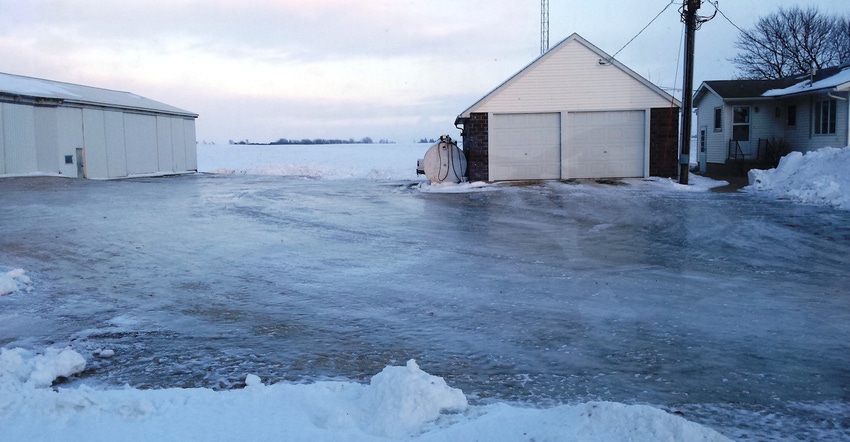
As I like to remind people, "Winter comes but once a year to northeast Iowa, and it usually stays for at least four months." This winter hasn't been much different. Our ground was covered with snow on December 4th and we haven't seen bare ground again since. You don't have to go very far south from here to get an area where the temperatures warm up and snow actually melts. That's the area where our TV stations tend to be. When they give a forecast, we can usually figure on being the caveat to it: "We'll see mild temperatures, except in our northern counties where they will see some snow." Or "We'll have normal winter driving conditions, except for those counties in the extreme northern part of our viewing area where they will have a winter storm warning, and travel is not recommended."
So we get fairly good at handling the weather we are dealt in the northern tier of counties in Iowa. Snow is one thing, but ice can be a totally different ballgame. In fact, after a recent weather event that covered a large portion of Iowa, I noticed one statewide radio report that mentioned how county road crews dislike ice more than snow. "You can ask any of the drivers – they’ll take feet of snow versus any ice at all,” according to the county engineer quoted in the story.
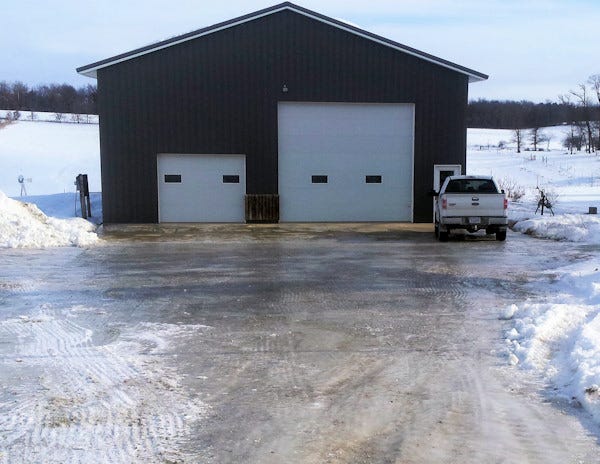
An icy surface and an incline are not great combinations - apply brakes and slide through the front door.
Icy yards create issues - in this case gently apply brakes and proceed into building.

An icy surface and an incline are not great combinations - apply brakes and slide through the front door.
Guess what? That was MY county engineer they talked to in the report. We're not just cold here in Winneshiek County; we're also hilly. Limited traction on ice is one thing. When you add in slope and momentum, the fun/frustration/terror goes up exponentially.
So why not add road salt and solve the problem, you ask? Salt works great on paved surfaces. The state highways are almost always in much better shape than county roads, because it's easier to add salt to them. Rural roads tend to be gravel, so the addition of salt can thaw some of the base under the ice and create a mushy mess when the substrate further down is still frozen. Salt isn't cheap, either, so now you've spent a bunch of money to get yourself a couple inches of mush on top of frozen gravel with a nice slush coating on top to keep it interesting.
Our county grader went by one day after an ice event with a tool for the occasion. It was a scarifier blade with almost a serrated edge to break up the ice on the road. The path it took wasn't full-width, but it got me a whole lot better traction down the middle of the road than I had before. Small grooves were carved in the ice. Those grooves improve traction tremendously.
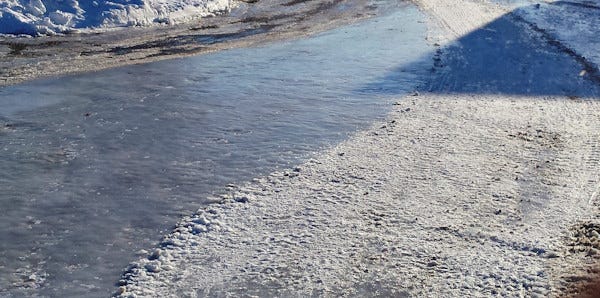
Using the scarifier on the ice can rough up the surface and make icy areas passable again.
A scarifier makes a big difference after a pass - creating better traction for all. Could a skid-steer attachment do the job?

Using the scarifier on the ice can rough up the surface and make icy areas passable again.
Those grooves also stop right at the roadway, which got me thinking.
If they can do that with a regular motor grader, why couldn't someone like me make something similar and put it on a skid loader and do my own yard with it? All you have to do is push on the brakes one time without having your forward momentum stop when you're on ice and you'll gain a whole different respect for traction. I did that once when delivering baleage with a loader tractor to a nearby customer. The hill on the way there wasn't all that long or steep, but I started to slide uncontrollably as I went down the hill. My first reaction was to drop the bale and try to use it as an emergency brake. The plastic wrap was still on the outside diameter of the bale, though, and it was slick, so it added all the friction of extra talcum powder! That's when I had a flashback to Drivers Ed and remembered comedian Mike Toomey talking about Film Strip Guy who would use his authoritarian voice to remind you to "steer into the skid!"
This was a slow-motion incident. I was doing maybe 10 or 11 miles per hour at the time. All I could hope for at that point was that I'd at least slide off the road into the ditch that wasn't as steep as the other side. Landing in one would probably get me an ambulance ride. The other side could be a hearse.
My forward motion finally came to a stop, but my thought process did not. There had to be a better way to get some traction without putting tire chains on everything I wanted to drive in the winter.
Another county employee, Brad, lives nearby and helped us after hours last fall during harvest. I decided I would send him a text to see if he could get me any old grader blade cutting edges that the county had taken off their machines. About the same time, I had seen a couple of metal projects on Facebook that yet another friend had done. Dick has a welding shop and does some very nice-looking fabrication work. Why not include him in my thought process, too? Guys with welding talent rarely run short on creativity.
It didn't take long to hear back from both friends. Dick would put his thinking cap on and see what he could figure out for me. He has a strong background in livestock and equipment, so he knows what it takes to keep a farmer happy with the right tool.
The reply from Brad was equally as good. Not only did he have access to used grader blades, but he had one at home that he had constructed and needed someone to test it, since he didn't have a skid loader handy to use himself.
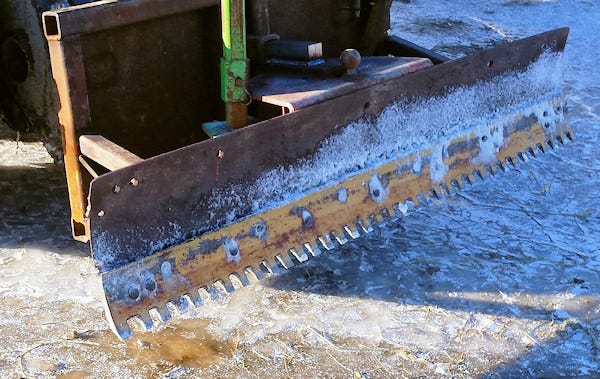
Friend, and county employee Brad, was already onto the idea of a scarifier for a skid-steer - and this is his version.
Friend Brad was already thinking about the idea of the skid-steer scarifier, and had one made. He just didn't have a skid-steer. We were happy to provide one for further product testing.

Friend, and county employee Brad, was already onto the idea of a scarifier for a skid-steer - and this is his version.
Man, I love it when a plan comes together!
We set up a time and I headed to Brad's in my skid loader for the experiment/adventure. Brad put a grader blade on a former three-point blade he had. He also used his plasma cutter to notch some teeth in the recycled cutting edge. Rather than just hook on and go home to try it, I decided I'd be a bit more generous and volunteer to do Brad's yard first to see how it worked. If there was an obvious flaw, why not break it in his yard and save myself the time of going back and forth to my place?
The scarifier was pretty effective. I scratched around Brad's yard and was impressed with how a fairly simple tool like that could change a yard from a sheet of ice to more normal driving conditions.
I took the new tool home and gave it a workout. We decided we should change a couple things to beef up the design. The weather forecast looked it would give us plenty of options to keep trying.
Meanwhile, Dick sent me a text to let me know he had his prototype done. He is familiar with my Team FIN experience, so he knows I'll give it a fair and objective review. My goal was to test each as well as I could in a fairly short amount of time. We even joked about the fact that I'd probably be the only person hoping for more ice this winter to expand my testing.
You can get used cutting edges for grader blades in 4-, 5-, 6- and 7-ft. lengths and combine them however you want for a desired width. Some situations call for a narrower cutting width, especially if you're working on a surface that isn't perfectly level. A little bit of a crown in a road or driveway leaves some un-scuffed surface if you try to scratch it with a 10- or a 12-foot wide tool. On the other hand, if you're doing fairly level ground, a wider tool makes much shorter work of the project.
The version that Dick sent home with me to try was an 8-ft. model. Dick didn't mess around. He went all-out and built a sturdy tool from the word go. There was a lot of heavy steel in it and plenty of bracing, because you never know what you might encounter when you're flying along making your own shaved ice. One little dip, or one little spot that melts can give you a divot that makes a golf course look like, well, a golf course! You don't just throw up divots with a tool like this. You throw up sod carpets and gravel piles. You also test engineering design and metal fatigue. Trust me, that's all I say.
The ice scarifier from Wise Welding and Fabrication sits far enough ahead of the skid loader that it's easy to see where your cutting edge is from the operator seat. You don't have to lean forward to see if you're getting anything accomplished, or if you're cutting too deep and digging up whatever lies below. The skid loader I used it with has an operating width of 75 inches. A 6-ft. wide blade wouldn't quite cover the tire tracks. When you're on ice, you don't want to come up short on traction, so I was glad I was plenty wide.
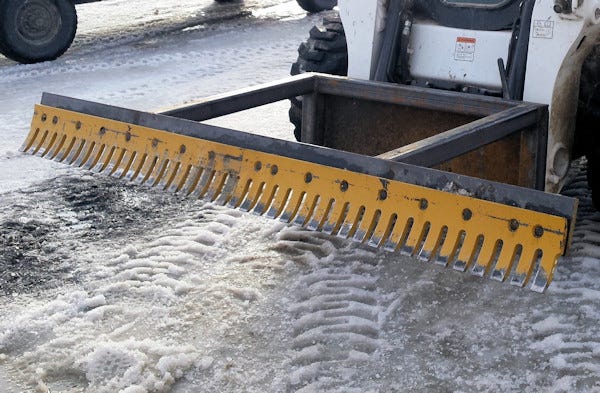
Friend Dick owns a welding shop, and this is the design he came up with for the skid-steer scarifier.
And this is the version our friend Dick, owner of a welding shop, came up with. It's 8-foot width really helped. More product testing on the neighbors' driveways is being conducted.

Friend Dick owns a welding shop, and this is the design he came up with for the skid-steer scarifier.
At the time of my testing, the temperature was approaching 32 degrees, so it was probably ideal conditions for breaking up ice. I got the tool out of my truck and hooked on with the skid loader. Then I proceeded to my driveway and the county road, seeing as how the county had not yet done my road. (I think they remember people who do a decent job of clearing their own road and move them down the priority list accordingly.)
My first pass with the scarifier was a little bit cautious until I got comfortable with it. Once that happened, it was hammer time! I put the blade down and let 'er rip as I headed toward the highway. There was a fountain of ice a little more than two feet high in front of me as I drove down the road. It was pretty much scraping right down to gravel and breaking up the ice perfectly.
What I really needed was a GoPro camera to capture the fun I was having. It probably wouldn't be hard to mount one to a helmet. Several people feel I should wear one of those routinely, anyway.
I'd argue if I could.
The next step was to expand my testing area. A guy gets his own yard done and he wants to keep the research going. Why not stop by and do some neighbors' driveways? Who's going to come out and chase me away for providing traction? There is usually a list of people whose driveways and yards I run around and clean whenever we get a major weather event. The list can't expand forever without limits, because I have my own work to do, too, but I know there are those who appreciate it and can't do it themselves. Now they'll get ice management to go with snow removal.
Really, who isn't in the mood for some shaved ice?
The test results were pretty promising. Both Dick's prototype and Brad's revised version held up well and got the job done. We were able to convert more than a couple yards from skating rinks to usable surfaces again. Getting some distance between the scarifier and the operator seemed to be the key. Not only do you get a better sight angle, but you can also change the angle and make it easier to get some down-pressure when it's needed. We talked about the need for more weight up front, maybe in the form of suitcase weights or something similar. I'm not sure that you could add enough weight without blocking the sight lines and making it harder to see what you're doing, or what you're about to hit. This isn't a giant parking lot with known barriers and borders, either. This is a farmyard. You never know what you'll find when you get going.
That's what keeps my job interesting.
Mr. Science
About the Author(s)
You May Also Like




